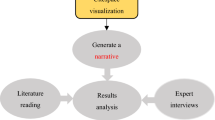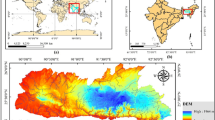Abstract
Here, we investigated the landslide susceptibility in the southern coast of the Caspian Sea, located in the northern part of Iran. This is of high importance for this area as it is highly touristic and agriculturally used and therefore of high value for the local inhabitants. Lack of landslide susceptibility map regarding this area is particularly a main motivation for this study. As a basis for modeling, a field mapping of different landslide types was performed. According to the field studies, this area has a high potential for landslide occurrence, and various kinds of mass movement can be observed all over the area. In order to preparing the area’s landslide susceptibility map, topographic, geotechnical, and landslide data were gathered, digitalized, and stored as raster layers. Then, using the infinite slope analysis, the static safety factor was determined in different conditions of saturation (m) and thickness (t) of landslide in order to get the most appropriate landslide susceptibility map. The accuracy of analysis was evaluated by comparing the recent landslides with the FS maps. The results indicated that the map obtained using m = 1 and t = 5 m compared with other maps has more compliance with the area. Therefore, this condition was used as cutoff in preparing the area’s landslide susceptibility map. This map comprises five susceptibility ranges: very low, low, moderate, high, and very high. This map shows that high percent of the region (36 %) is subject to landslides. The landslide susceptibility map was verified using 69 older landslides in the area. The results indicated that most of the landslides in the area were concentrated in high and very high susceptibility classes. The landslide susceptibility map prepared in this study can be practical in engineering projects and architectural activities in the investigated area.










Similar content being viewed by others
References
Alijani B (2011) Climate of Iran. Payame Noor University Publisher, Tehran (In Persian)
Ayalew L, Yamagishi H (2005) The application of GIS-based logistic regression for landslide susceptibility mapping in the Kakuda-Yahiko Mountains, Central Japan. Geomorphology 65(1–2):15–31
Ayalew L, Yamagishi H, Ugawa N (2004) Landslide susceptibility mapping using GIS-based weighted linear combination, the case in Tsugawa area of Agano River, Niigata Prefecture, Japan. Landslides 1:73–81
Ayalew L, Yamagishi H, Marui H, Kanno T (2005) Landslides in Sado Island of Japan: part II. GIS-based susceptibility mapping with comparisons of results from two methods and verifications. Eng Geol 81(4):432–445
Barredo JI, Benavides A, Hervas J, Van Westen CJ (2000) Comparing heuristic landslide hazard assessment techniques using GIS in the Tirajana basin, Gran Canaria Island, Spain. Int J Appl Earth Obs Geoinf 2:9–23
Blake TF, Hollingsworth R, Stewart J (2000) Recommended procedures for implementation of DMG special publication 117 guidelines for analyzing and mitigating landslide hazards in California. American Society of Civil Engineers Los Angeles Section, Los Angeles, CA
Brardinoni F, Slaymaker O, Hassan MA (2003) Landslide inventory in a rugged forested watershed: a comparison between air-photo and field survey data. Geomorphology 54(3–4):179–196
Can T, Nefeslioglu HA, Gokceoglu C, Sonmez H, Duman TY (2005) Susceptibility assessments of shallow earthflows triggered by heavy rainfall at three catchments by logistic regression analyses. Geomorphology 72(1–4):250–271
Cruden DM, Varnes DJ (1996) Landslide types and processes. In: Schuster RL, Turner AK (eds) Landslides, investigation and mitigation. Transportation research board special report 247, National Academy Press, Washington, DC, pp 36–75
Dai FC, Lee CF (2002) Landslide characteristics and slope instability modeling using GIS, Lantau Island, Hong Kong. Geomorphology 42(3–4):213–228
Dai FC, Lee CF, Li J, Xu ZW (2001) Assessment of landslide susceptibility on the natural terrain of Lantau Island, Hong Kong. Environ Geol 40(3):381–391
Darvishzadeh A (2004) Geology of Iran. Amirkabir Publisher, Tehran (In Persian)
Dong JJ, Tung YH, Chen CC, Liao JJ, Pan YW (2011) Logistic regression model for predicting the failure probability of a landslide dam. Eng Geol 117(1–2):52–61
Evans SG, Roberts NJ, Ischuk A, Delaney KB, Morozova GS, Tutubalina O (2009) Landslides triggered by the 1949 Khait earthquake, Tajikistan, and associated loss of life. Eng Geol 109(3–4):195–212
Fatemi Aghda SM (1994) Evaluation of geological hazard risks using multi-criteria evaluation, techniques. Dissertation, Kumamoto University, Japan
Forests, Range and Watershed Management Organization of Iran (2007) Data of landslides in Iran. Unpublished report, 60 p (In Persian)
García-Rodríguez MJ, Malpica JA, Benito B, Diaz M (2008) Susceptibility assessment of earthquake-triggered landslides in El Salvador using logistic regression. Geomorphology 95(3–4):172–191
Greco R, Sorriso-Valvo M, Catalano E (2007) Logistic regression analysis in the evaluation of mass movements susceptibility: the Aspromonte case study, Calabria, Italy. Eng Geol 89(1–2):47–66
GSI, Geological survey of Iran (2001) Geological map of chalus and ramsar, Scale 1:100,000
Guzzetti F, Carrara A, Cardinali M, Reichenbach P (1999) Landslide hazard evaluation: a review of current techniques and their application in a multi-scale study, Central Italy. Geomorphology 31(1–4):181–216
Harp EL, Crone AJ (2006) Landslides triggered by the October 8, 2005 Pakistan earthquake and associated landslide-dammed reservoirs. U.S. geological survey open-file report 2006–1052. 10 p. http://pubs.usgs.gov/of/2006/1052/pdf/ofr-2006-1052.pdf
Harp EL, Held MD, Castaneda MR, Mckenna JP, Jibson RW (2002) Landslide hazard map of Tegucigalpa, Honduras. U.S. Geological survey open-file report 02-219. 9p
Harp EL, Michael JA, Laprade WT (2006) Shallow-Landslide Hazard Map of Seattle, Washington. U.S. Geological survey open-file report 06-1139. 20p
Harp EL, Reid ME, McKenna JP, Michael JA (2009) Mapping of hazard from rainfall-triggered landslides in developing countries: examples from Honduras and Micronesia. Eng Geol 104(3–4):295–311
Hoek E, Bray JW (1981) Rock slope engineering. The Institute of Mining and Metallurgy, London
Jibson RW, Harp EL, Michael JA (2000) A method for producing digital probabilistic seismic landslide hazard maps. Eng Geol 58:271–289
Kamp U, Growley BJ, Khattak GA, Owen LA (2008) GIS-based landslide susceptibility mapping for the 2005 Kashmir earthquake region. Geomorphology 101(4):631–642
Kawabata D, Bandibas J (2009) Landslide susceptibility mapping using geological data, a DEM from ASTER images and an Artificial Neural Network (ANN). Geomorphology 113(1–2):97–109
Khamehchiyan M, Abdolmaleki P, Rakei B (2011) Landslide susceptibility mapping using backpropagation neural networks and logistic regression: the Sephidargole case study, Semnan, Iran. Geomech Geoeng 6(3):237–250
Komac M (2006) A landslide susceptibility model using the Analytical Hierarchy Process method and multivariate statistics in perialpine Slovenia. Geomorphology 74(1–4):17–28
Miles SB, Keefer DK (2001) Seismic landslide hazard for the city of Berkeley, CA. MAP MF-2378. USGS, U. S. Department of the Interior
Nandi A, Shakoor A (2009) A GIS-based landslide susceptibility evaluation using bivariate and multivariate statistical analyses. Eng Geol 110(1–2):11–20
Nasiri S (2005) Seismic landslide hazard zonation for the northern Tehran. Dissertation, Tarbiat Modares University (In Persian)
Neaupane KM, Piantanakulchai M (2006) Analytic network process model for landslide hazard zonation. Eng Geol 85(3–4):281–294
Nefeslioglu HA, Gokceoglu C, Sonmez H (2008) An assessment on the use of logistic regression and artificial neural networks with different sampling strategies for the preparation of landslide susceptibility maps. Eng Geol 97(3–4):171–191
Sarkar S, Anbalagan R (2008) Landslide hazard zonation mapping and comparative analysis of hazard zonation maps. J Mt Sci 5(3):232–240
Schulz WH (2007) Landslide susceptibility revealed by LIDAR imagery and historical records, Seattle, Washington. Eng Geol 89(1–2):67–87
Tien Bui D, Pradhan B, Lofman O, Revhaug I, Dick OB (2012) Landslide susceptibility mapping at Hoa Binh province (Vietnam) using an adaptive neuro-fuzzy inference system and GIS. Comput Geosci 45:199–211
Van Den Eeckhaut M, Vanwalleghem T, Poesen J, Govers G, Verstraeten G, Vandekerckhove L (2006) Prediction of landslide susceptibility using rare events logistic regression: a case-study in the Flemish Ardennes (Belgium). Geomorphology 76(3–4):392–410
Wang R (2008) An expert knowledge-based approach to landslide susceptibility mapping using GIS and fuzzy logic. Dissertation, University of Wisconsin-Madison. http://www.mazandaranmet.ir. (Website of Mazandaran Meteorological Office)
Wang HB, Sassa K (2005) Comparative evaluation of landslide susceptibility in Minamata area, Japan. Environ Geol 47:956–966
Yalcin A (2008) GIS-based landslide susceptibility mapping using analytical hierarchy process and bivariate statistics in Ardesen (Turkey): comparisons of results and confirmations. Catena 72:1–12
Yalcin A, Reis S, Aydinoglu AC, Yomralioglu T (2011) A GIS-based comparative study of frequency ratio, analytical hierarchy process, bivariate statistics and logistics regression methods for landslide susceptibility mapping in Trabzon, NE Turkey. Catena 85(3):274–287
Yesilnacar E, Topal T (2005) Landslide susceptibility mapping: a comparison of logistic regression and neural networks methods in a medium scale study, Hendek region (Turkey). Eng Geol 79(3–4):251–266
Yilmaz I (2009) Landslide susceptibility mapping using frequency ratio, logistic regression, artificial neural networks and their comparison: a case study from Kat landslides (Tokat–Turkey). Comput Geosci 35(6):1125–1138
Yoshimatsu H, Abe S (2006) A review of landslide hazards in Japan and assessment of their susceptibility using an analytical hierarchic process (AHP) method. Landslides 3:149–158
Author information
Authors and Affiliations
Corresponding author
Rights and permissions
About this article
Cite this article
Setayeshirad, M.R., Nikudel, M.R. & Uromeihy, A. Landslide susceptibility assessment along the southern coast of the Caspian Sea, Iran. Nat Hazards 69, 2215–2232 (2013). https://doi.org/10.1007/s11069-013-0802-z
Received:
Accepted:
Published:
Issue Date:
DOI: https://doi.org/10.1007/s11069-013-0802-z




